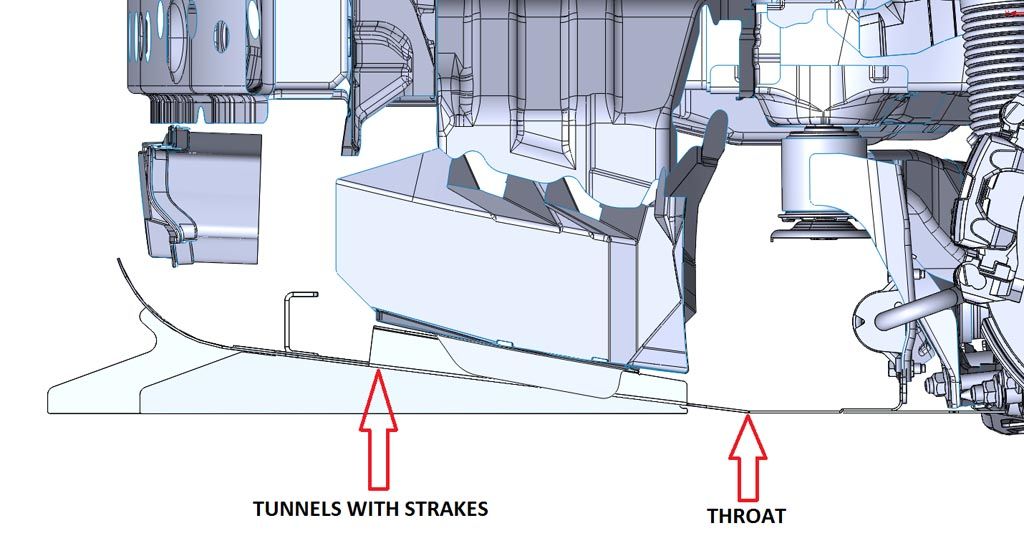Diffuser Functionality is Often Misunderstood
Automotive and motorsport diffusers functionality is a big misconception to the general car public because aerodynamics are not always intuitive. We preach this often and will continue to do so as analysis is one of the only ways to truly understand and improve functionality. Diffusers do not work in the same way as a wing or a closed duct. In today’s blog post, we dive into diffuser functionality and understanding their quirks.
What are diffusers and where are they located?
Diffusers, in motorsports, are aerodynamic devices typically located on the underside of the vehicle to aid in aerodynamic performance by using ground effects. Diffusers are normally located in the rearmost section of the floor and/or on the rear section of a front splitter. We will be specifically reviewing and discussing rear diffusers in this blog post though writing here...
.jpg?access_token=c21ef2a5-34cb-4968-9a05-1c0bba1ad557)
Example of Rear Diffuser

Example of Front Diffuser
Diffuser Basics
Let’s get to the basics of how a diffuser operates, but keep in mind the basics are just that. They do not explain the entire function as diffusers can become quite complex in both design and operation. Diffusers take advantage of the Venturi effect which applies Bernoulli’s principle to a fluid flowing through a constricted section of a pipe. If the flow is constricted, the local velocity increases and the pressure decreases as shown in the picture below. Diffusers utilize this low pressure to create downforce.

Diffuser Verbiage
Diffusers have various locations of importance worth noting. The area constricted on an automotive diffuser is called the throat. The tunnel is behind the throat and has an upward angle. Strakes are vertical fences which can aid and improve

So what is happening within the diffuser at these locations?
At the throat, flow is increasing in velocity. This creates a low-pressure area, creating downforce. This location will have the lowest pressure of the entire diffuser. Flow inside of the tunnels of the diffuser

What is the tunnel’s function?
The throat is the region where the high velocity and low pressure is located, which is very important for function and downforce production. However, the tunnel is also quite important to overall downforce performance. The tunnel slows the airspeed down in a controlled fashion to recover the pressure. The goal here is to have the outlet pressure of the diffuser around atmospheric pressure to recover as much of the pressure as possible. Doing this properly will have a big impact on the drag of the car, in a positive way. Doing so poorly will have the opposite effect.
Common Misconception of Tunnels
One of the common misconceptions of diffusers has to do with the tunnel. Most people believe that flow needs to be fully attached for the diffuser’s tunnel portion to work properly. This is incorrect. A diffuser does not need attached laminar flow to extract maximum performance, vortices come into play which completely changes the equation.

Complex flow entering diffuser in the form of a vortex
When visualizing the complex flow on the diffuser, typically with flow visualization fluid, some may look at this flow and feel that the diffuser is not functioning correctly. The reasoning for this is the introduction of vortices makes the surface flow look very complex and to the untrained eye, it could look like improper flow or a design flaw. See the photo below for a visualization of this.

Even with a diffuser that has

This flow might look worse than the previous picture, but this produces even more downforce
What are the functions of strakes?
Strakes are the vertical fences that can be visualized on diffusers, normally in the tunnels. Strakes serve two main functions: keep tire squirt from the diffuser tunnels and to be vortex generators.

Tire squirt can be seen behind the tire (blue on the
Tire squirt can be minimized by using strakes to reduce the amount of tire wake making its way into the diffuser tunnel. Reducing the airflow from the wheels increases diffuser performance.
Strakes are also vortex generators, but are a little more complex and definitely harder to design for this goal. This is because the vortex needs to be in the actual tunnel of the diffuser to improve performance. A vortex in the tunnel will have increased lower pressure which equals more downforce.

In Conclusion
It is easy to see from these pictures why it is difficult to determine performance just by looking at a diffuser, or even by looking at the flow on the surface of a diffuser with just flow vis. Diffusers cannot be viewed the same way as a wing; flow does not need to stay fully attached to the underside surface on a rear diffuser. The flow is much more complex on a diffuser and has quite a few more variables involved than a wing.
Some other aspects we have not taken a deep look at in this blog post are tunnel angle, ride heights, and vehicle speed. All of these affect the diffuser function in a large way and are things we monitor through CFD analysis during the design phase. To complicate this further, different chassis/vehicles respond differently to each aspect listed above.
Diffusers - How They Work